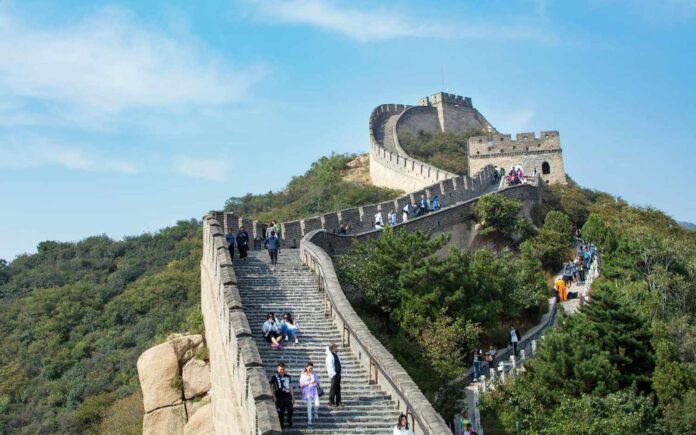Welcome to this post on Crazy Truths about the Top 10 Tourist Attractions in the World via Afrokonnect.
Hey there, fellow travel enthusiasts! Are you ready to have your mind blown by some crazy truths about the top 10 tourist attractions in the world?
From the Great Wall of China to the Burj Khalifa, these iconic landmarks have secrets and stories that will leave you speechless. Get ready to uncover the unknown, the bizarre, and the fascinating facts about the most visited places on Earth.
Buckle up folks, because in this post, we’ll take you into the crazy truths you didn’t know about the top 10 tourist attractions in the world!
1. THE GREAT WALL OF CHINA IS NOT VISIBLE FROM SPACE
Contrary to popular belief, the Great Wall of China is not visible from space. This myth has been debunked by astronauts and satellite images, but it’s still a widely-held belief.
The wall is simply too small and too similar in color to the surrounding terrain to be visible from space. In fact, it’s only about 30 feet wide and 20 feet tall, which is tiny compared to the vastness of the Earth’s surface.
However, it’s still an impressive feat of engineering and an evidence of ancient Chinese civilization. The wall stretches over 4,000 miles, making it one of the longest structures ever built.
The Great Wall was built over several centuries to protect the Chinese Empire from invading armies. It’s made of stone, brick, and rammed earth and it’s been restored and extended many times over the centuries. Today, it’s one of the most popular tourist attractions in China, and it’s a UNESCO World Heritage Site.
2. THE TAJ MAHAL CHANGES COLOR
The Taj Mahal, one of the most beautiful buildings in the world, changes color depending on the time of day and the weather. The marble used to build the mausoleum is highly sensitive to light and can appear pinkish in the morning, white during the day, and golden at sunset.
This phenomenon is due to the unique properties of the marble and the way it reflects light. The Taj Mahal is made of white Makrana marble, which is prized for its beauty and durability. The marble was brought from the nearby town of Makrana, and it’s said to have been chosen for its ability to change color in different lighting conditions.
The Taj Mahal was built by the Mughal emperor Shah Jahan in memory of his beloved wife, Mumtaz Mahal. It took over 20 years to build and was completed in 1653. The building is surrounded by beautiful gardens and a large reflecting pool, which adds to its beauty and tranquility. Today, the Taj Mahal is one of the most visited tourist attractions in India, and it’s a UNESCO World Heritage Site.
3. MACHU PICCHU WAS BUILT ON A FAULT LINE
Machu Picchu, the ancient Inca city, was built on a fault line. This might seem crazy, but the Incas were skilled engineers who knew how to build structures that could withstand earthquakes. The city’s architecture is designed to flex and absorb seismic activity, making it one of the most resilient ancient structures in the world.
Machu Picchu was built in the 15th century during the reign of the Inca emperor Pachacuti. It’s believed to have been used as a religious and ceremonial center, and it’s surrounded by beautiful mountains and lush forests. The city was abandoned before the arrival of the Spanish conquistadors and remained hidden for centuries, until its rediscovery in 1911.
Today, Machu Picchu is one of the most famous and mysterious sites in South America, and it’s a UNESCO World Heritage Site.
4. THE COLOSSEUM WAS BUILT WITH VOLCANIC ROCK
The Colosseum, Rome’s iconic amphitheater, was built with volcanic rock. The rock was sourced from nearby volcanoes and was used to construct the building’s foundation and walls. This unique building material has helped the Colosseum withstand the test of time and remain one of the most impressive ancient structures in the world.
The Colosseum was built in the 1st century AD during the reign of the emperor Vespasian. It was used for gladiatorial contests, animal hunts, and public executions, and it could hold up to 50,000 spectators. The building’s architecture is a testament to ancient Roman engineering and design, and it’s still an iconic symbol of Rome today.
5. THE EIFFEL TOWER WAS ORIGINALLY INTENDED AS A TEMPORARY STRUCTURE
The Eiffel Tower, one of the most iconic landmarks in the world, was originally intended as a temporary structure. It was built for the 1889 World’s Fair and was meant to be dismantled after the event. However, it became an instant icon of Paris and was left standing. Today, it’s one of the most visited tourist attractions in the world, and it’s a UNESCO World Heritage Site.
The Eiffel Tower was designed by Gustave Eiffel and took over two years to build. It’s made of iron and stands over 1,000 feet tall, making it one of the tallest structures in the world at the time of its completion. The tower was intended to be a symbol of French engineering and innovation, and it’s still a source of pride for the French people today.
6. THE PYRAMIDS OF GIZA WERE BUILT WITH OVER 2 MILLION STONE BLOCKS
The Pyramids of Giza, one of the Seven Wonders of the Ancient World, were built with over 2 million stone blocks. Each block weighs around 2.5 tons, making the pyramids some of the most impressive architectural achievements in history. The pyramids were built using simple yet effective techniques that have been lost to time.
The Great Pyramid of Giza, the largest of the three pyramids, is an astonishing 481 feet tall and contains over 2.3 million stone blocks. It’s estimated that it took around 20 years to build and required the labor of thousands of workers. The pyramids were built as tombs for the pharaohs of Ancient Egypt and were believed to provide a means for the pharaohs to ascend to the afterlife.
7. THE ACROPOLIS OF ATHENS WAS BUILT ON A ANCIENT SETTLEMENT
The Acropolis of Athens, home to the Parthenon, was built on an ancient settlement. The site has been inhabited for over 5,000 years, making it one of the oldest continuously occupied sites in the world. The Acropolis has been destroyed and rebuilt several times throughout history, but its rich cultural heritage remains intact.
The Parthenon, the most famous building on the Acropolis, was built in the 5th century BC during the Golden Age of Athens. It was designed by the famous architects Ictinus and Callicrates and took around 15 years to complete. The building is a masterpiece of Doric architecture and is considered one of the greatest cultural achievements of Ancient Greece.
8. CHRIST THE REDEEMER WAS BUILT WITH SOAPSTONE
Christ the Redeemer, the iconic statue in Rio de Janeiro, was built with soapstone. The statue was designed by the French sculptor Paul Landowski and took around 10 years to complete. It was built using soapstone, a type of metamorphic rock, which gives it its distinctive appearance.
The statue is over 98 feet tall and is made up of six segments. It was built on the peak of the Corcovado Mountain and is visible from many parts of the city. The statue is a symbol of Christianity and is one of the most iconic landmarks in the world.
9. CHICHÉN ITZÁ WAS BUILT BY THE MAYANS AS AN OBSERVATORY
Chichén Itzá, one of the most famous Mayan ruins, was built as an observatory. The pyramid’s architecture is designed to align with the movements of the sun, moon, and stars. The Mayans were skilled astronomers who used their knowledge of the universe to build structures that could track celestial events.
The pyramid, known as El Castillo, is over 75 feet tall and has nine levels. Each level represents a different level of the Mayan underworld, and the stairs leading up to the top represent the connection between the underworld and the world of the living. The pyramid is a testament to the advanced knowledge of the Mayans and their sophisticated understanding of astronomy.
10. THE BURJ KHALIFA IS SINKING
The Burj Khalifa, the tallest building in the world, is sinking. The building’s foundation is designed to settle into the ground over time, which can cause it to sink by up to 1 inch per year. This might seem alarming, but it’s a normal process for buildings of this height. The Burj Khalifa is still an impressive feat of engineering and a proof of human ingenuity.
The building stands over 2,722 feet tall and has 163 floors. It was designed by the American architectural firm Skidmore, Owings & Merrill and took around six years to complete. The building is a symbol of Dubai’s wealth and ingenuity and is one of the most iconic landmarks in the world.
CONCLUSION ON CRAZY TRUTHS ABOUT THE TOP 10 TOURIST ATTRACTIONS IN THE WORLD
And there you have it! Crazy truths about the top 10 tourist attractions in the world, with its secrets and stories that will blow your mind. From the Great Wall of China to the Burj Khalifa, these iconic landmarks have fascinating facts and secrets that are just waiting to be uncovered. Whether you’re a history buff, an architecture enthusiast, or simply a curious traveler, these crazy truths will make you see these attractions in a whole new light.
So, the next time you visit one of these iconic landmarks, remember the fascinating stories and secrets behind them. From the ancient civilizations that built them to the modern-day engineering marvels that make them stand tall, these attractions are more than just tourist traps – they’re gateways to understanding the human experience.
And who knows? You might just discover a new favorite attraction or a new appreciation for the history and culture that surrounds us all. Happy travels, folks!
On that note, this brings us to the end of this post on Crazy Truths about the Top 10 Tourist Attractions in the World. Thanks for reading and we hope to see you again on Afrokonnect.ng.
















